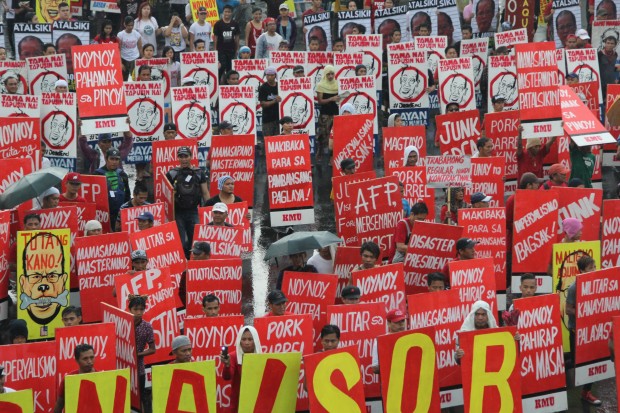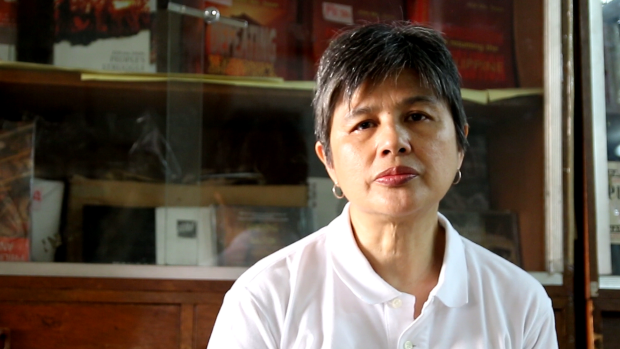STREETWISE: Manilakbayan 2015’s opening salvo by Carol Pagaduan-Araullo
Streetwise
Lumad extrajudicial killings and forced evacuations due to military and paramilitary forces rampaging across the indigenous people’s ancestral domain in the remaining frontiers of Mindanao have finally made its mark on the national public consciousness.
The arrival of the Manilakbayan 2015, a contingent of more than 700 people who traveled from Mindanao to Manila by land, consisting of lumad from different tribes, peasants, trade unionists and social activists, has served as a dramatic and colorful high point of the campaign to seek justice for gross human rights violations; to defend lumad schools, communities, land and resources; and to resist corporate plunder and government’s war against the people of Mindanao in the guise of fighting insurgency.
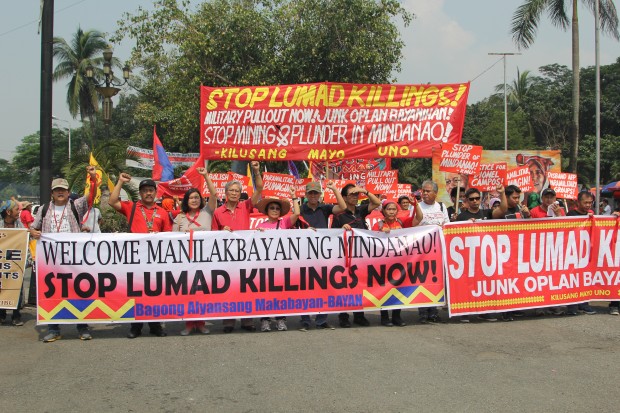
While the sorry plight of the lumad “bakwit” (a colloquial Filipinized term for evacuees) has been ongoing for far longer, certain developments served to bring it to the fore. One was the frustrated attempt by North Cotobato representative Nancy Catamco, with the help of hundreds of police, paramilitary groups and other government people, to force about 700 Manobo evacuees who had taken refuge in a church compound in Davao City to go back to where they came from. Erstwhile presidentiable, Davao City mayor Duterte, intervened to avert more violence, providing buses for those willing to leave voluntarily but not one availed of his offer.
The other dramatic event was the brutal murder of the executive director of ALCADEV, a lumad school in Surigao del Sur and two lumad leaders and the burning of a lumad cooperative, by paramilitary forces under the wing of the Armed Forces of the Philippines (AFP). This led to another exodus, this time by close to 3000 individuals – men, women and children – to the provincial capital, Tandag City.
The killings and arson were condemned as the handiwork of right-wing paramilitary death squads recruited from among the lumad by the AFP. The military tried to distance themselves from the killers and turn the tables on the victims by tarring them as supporters of the New People’s Army (NPA). When this didn’t work, the AFP and Malacanang tried to echo the call for a stop to lumad killings while blurring who are behind such killings and for what reasons or else pointing to the NPA as the culprit.
Now the Manilakbayan is serving as a compelling and hard hitting testimonial not only to the travails of the lumad and other oppressed people in Mindanao but to their heightened social and political awareness; their courage and steadfastness in the defense of their organizations, schools and communities; and to their pride in their culture and traditions harnessing these to assert their rights as a people.
During the five-day caravan through Eastern Visayas, the Bicol region and Southern Tagalog, the Manilakbayan caravan was warmly welcomed. The “lakbayanis” were provided food, lodging and other wherewithal to ease their stay. They held rallies in major stops to explain the issues and demands they carried. There were cultural exchanges with various groups especially the lumad youth with their counterparts.
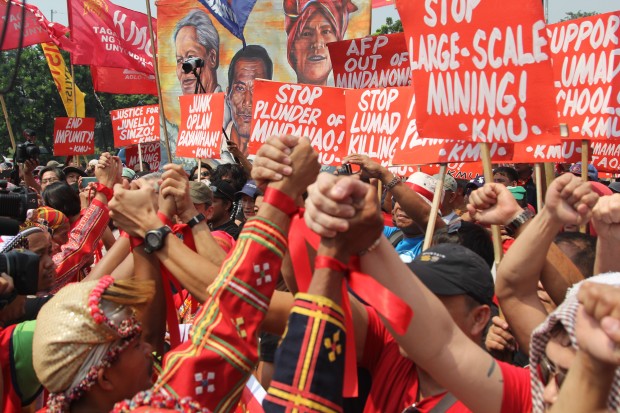
Their journey culminated in their triumphant entry into Metro Manila wherein the Baclaran church gave them a place to rest briefly overnight; students and teachers from St. Scholastica, De La Salle, Philippine Christian College, Philippine Normal College and University of Santo Tomas welcomed and cheered them on the following day; a “salubungan” and solidarity lunch took place with various sectors at the Bonifacio Shrine; the Manilakbayan and their welcomers marched to Mendiola to bring their protest to the doorstep of the Presidential Palace; followed by the final leg, the caravan to the Diliman campus of the University of the Philippines (UP).
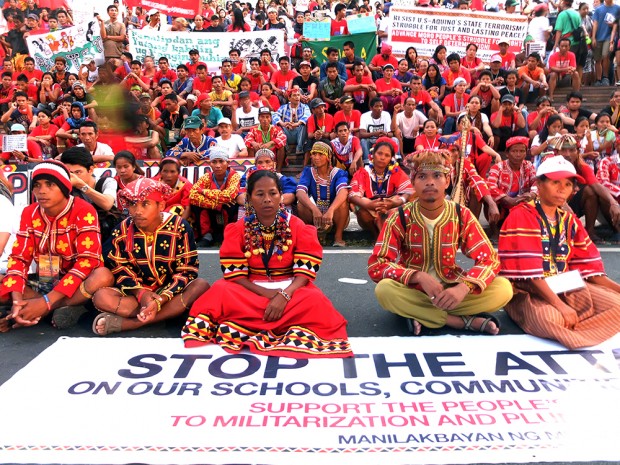
As hundreds of thousands of UP student activists have done in decades, the Lumad sit in front of Palma Hall for a protest action.
At UP, the long day was capped by a huge, rousing welcome in front of the iconic Oblation statue symbolizing academic freedom and the university’s avowed service to the people, with flags waving and people chanting and cheering. Manilabayan leaders gave UP Chancellor Michael Tan a red tubao to wear on his head while the latter handed out several “sablay” or the UP sash worn at graduation and other formal events to the leaders.
The UP community laid down a red carpet welcome for the Manilakbayan not in terms of luxurious accommodations (they were assigned a wide, open space near Commonwealth Avenue where camp of make-shift kitchen and dining area, shower rooms and toilets, and sleeping quarters were set up by UP personnel and volunteers) but in terms of a week-long series of events open to the public.
There was a press conference held at the historic stairs fronting the old College of Arts and Sciences or “AS steps” with UP officials formally receiving the Manilakbayan contingent (present en masse in a sea of colorful but mainly red traditional garb). The lumad performed a ritual to bless their stay and their hosts. It was a joy to see lumad kids playing basketball with the UP varsity team. There was a steady stream of visitors to the camp both UP and non-UP denizens to interact with the guests and to take photos to memorialize the occasion.
In the daytime there were conferences, forums and group discussions such as on agribusiness and mining corporations continuing to monopolize land in Mindanao and fast encroaching on lumad ancestral domain as well as on prospects for peace in Muslim Mindanao with the uncertain passage of a highly diluted Bangsamoro Basic Law (BBL). There were also protests at government offices such as the Commission on Human Rights and the National Commission on Indigenous People seen as veritable accomplices to the impunity with which state forces were attacking the lumad.

At night there were cultural solidarity sessions in the camp as well as fund raising events such as the one held for lumad schools by musicians and artists that even featured the Filipino choreographer and dance historian Ligaya Fernando-Amilbangsa who has been awarded for her lifework of documenting and teaching the “pangalay”, a pre-Islamic dance tradition among the peoples of Sulu and Tawi-Tawi.
Despite initial trepidation by some quarters that UP’s hosting of the Manilakbayan might be disruptive of the university’s daily life as an academic institution or worse, be interpreted as aiding and abetting those that the AFP is wont to label as “enemies of the state”, both the hosts and the guests were one in declaring the one week UP stay of the Manilakbayan as a bona fide, if unique, learning experience for all. It also underscored the fact that in UP, the counterculture of protest is alive and well and that UP’s other moniker as the “University of the People” stands on firm ground.
The Manilakbayan moves to the Liwasang Bonifacio where they will set up camp for the following weeks until the protests for the upcoming APEC Summit. The “lakbayanis” are well aware that policies of neoliberal globalization including the policy of opening up the economy and national patrimony to unbridled exploitation by multinational corporations are behind the intensification of plunder and war in Mindanao.
It is hoped that the Manilakbayan’s highlighting of the urgent issues and demands of the people of Mindanao, especially the lumad, will lead to the dismantling of paramilitary groups, the demilitarization of lumad areas, justice for victims of extrajudicial killings and other human rights violations and the further unmasking of the destructive forces of monopoly capitalist greed and bureaucrat capitalist corruption that are at the root of their exploitation and oppression. #
Published in Business World
2 November 2015

